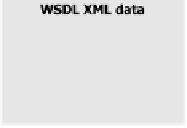Information Technology Reference
In-Depth Information
the service can be interpreted semantically. In other words, the outgoing data
must be transformed from an ontological format to XML and, conversely, the
incoming data must be transformed from XML to an ontological format. Since
the semantics of XML data is only implicit - at best it is only described in
plain text - a human designer is required to specify these data transformations
so that they can be executed when a semantic client needs to communicate
with a syntactic Web service.
In Fig. 9.9 we present a systematic way of distinguishing between the
various approaches to data grounding. The figure shows a fragment of the
ontology of the semantic description of an example Web service in the upper
right corner and the XML data, described in WSDL, in the lower left corner.
The three different paths between the XML data quadrant and the semantic
quadrant represent different options for where the transformations can be
implemented: at the XML level, at the semantic level, or the direct option
spanning between the two levels.
Fig. 9.9.
Approaches to data grounding
First, since semantic Web ontologies can be serialized in XML, an XSLT
(or similar) transformation can be created between the XML data and the
XML serialization of the ontological data. Only in the case where the XML
format of the ontological data is actually suitable for a particular Web service
can the transformation can be avoided. Second, an ad hoc ontology can be
generated from the XML Schema present in the WSDL document (upper left
corner), with automatic transformations (
lifting/lowering
) between the XML
data and their equivalent in the ad hoc ontology. Then a transformation using
an ontology-mapping language can be designed to get to the target ontology.
Finally, a direct approach to mapping between the XML data and the target
semantic data is also possible.































































Search WWH ::

Custom Search